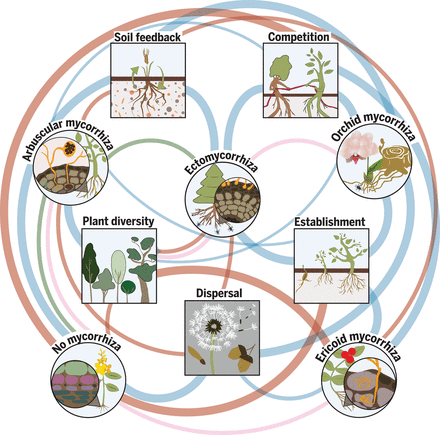
The pervasive power of mycorrhizas
Associations between plants and symbiotic fungi—mycorrhizas—are ubiquitous in plant communities. Tedersoo et al. review recent developments in mycorrhizal research, revealing the complex and pervasive nature of this largely invisible interaction. Complex networks of mycorrhizal hyphae connect the root systems of individual plants, regulating nutrient flow and competitive interactions between and within plant species, controlling seedling establishment, and ultimately influencing all aspects of plant community ecology and coexistence.
Science, this issue p. eaba1223
Structured Abstract
BACKGROUND
All vascular plants associate with fungi and bacteria—the microbiome. Root associations with mycorrhizal fungi benefit most plants by enhancing their nutrient access and stress tolerance. Mycorrhizal fungi also mediate plant interactions with other soil microbes, including pathogens and mycorrhizosphere mutualists that produce vitamins and protect against antagonists. Through these functions, mycorrhizal root symbionts influence the belowground traits of plants, regulate plant-plant interactions, and alter ecosystem processes. Extensive mycorrhizal networks physically connect conspecific and heterospecific plant individuals belowground, mediating nutrient transfer and transmission of phytochemical signals. Arbuscular mycorrhiza (AM), ectomycorrhiza (EcM), ericoid mycorrhiza (ErM), and orchid mycorrhiza (OM) have a distinct evolutionary history, anatomy, and ecology, thereby differently affecting plant protection, nutrient acquisition, and belowground C and nutrient cycling.
ADVANCES
Mycorrhizal fungi are commonly the key determinants of plant population and community dynamics, with several principal differences among mycorrhizal types. We synthesize current knowledge about mycorrhizal effects on plant-plant interactions and ecological specialization. We conclude that mycorrhizal associations per se and fungal diversity and mycorrhizal types directly or indirectly affect plant dispersal and competition that shape plant populations and communities, and regulate plant coexistence and diversity at a local scale. Among AM plants, which represent nearly 80% of plant species globally, mycorrhizal associations and belowground hyphal networks tend to intensify intraspecific competition and alleviate interspecific competition by promoting the performance of inferior competitors. In AM systems, fungal diversity enhances plant diversity and vice versa, by providing species-specific benefits and suppressing superior competitors. Compared with other mycorrhizal types, EcM fungi provide substantial protection against soil-borne pathogens by ensheathing feeder roots and acidifying soil. Pathogen suppression leads to positive plant-soil feedback that promotes seedling establishment near adult trees, which can result in monodominant plant communities with a low diversity of various organism groups. Orchids produce millions of dust seeds with high dispersal potential to encounter compatible OM fungal partners, which nourish plants, at least in the seedling stage. Species of Ericaceae achieve competitive advantage and large population densities by shedding allelopathic litter and establishing ErM root symbiosis with selected groups of ubiquitous humus saprotrophs that have evolved efficient enzymes to access nutrients in recalcitrant organic compounds in strongly acidic environments.
OUTLOOK
Increasing evidence suggests that mycorrhizal fungi drive plant population biology and community ecology by affecting dispersal and establishment and regulating plant coexistence. Plant-fungal mycorrhizal associations per se and interlinking hyphal networks synergistically determine the functional traits and hence autecology of host plants, which is best reflected in the specialized nutrition and dispersal of orchids. Habitat patches dominated by either positive plant-soil feedback near EcM plants or negative conspecific feedback near AM plants may generate distinct regeneration patches for different plant species. Furthermore, niche differentiation both within and among mycorrhizal types enhances coexistence by leveraging interspecific competition through different rooting depths, foraging strategies, and soil nutrient partitioning. We still lack critical information about the mechanistic basis of several processes, such as interplant nutrient transfer through mycelial networks and the principles of carbon-to-nutrient exchange and trading in the mycorrhizal interface, as well as kin recognition and promotion. Understanding these processes will enable us to improve predictions about the impacts of global change and pollution on vegetation and soil processes and to elaborate technologies to improve yields in agriculture and forestry.
Blue lines, positive effects; red lines, negative effects; green lines, overlap of plant taxa among mycorrhizal types; pink lines, overlap of fungal taxa among mycorrhizal types. Line breadth indicates relative effect strength.
ILLUSTRATION: SIIRI JÜRIS
Abstract
Mycorrhizal fungi provide plants with a range of benefits, including mineral nutrients and protection from stress and pathogens. Here we synthesize current information about how the presence and type of mycorrhizal association affect plant communities. We argue that mycorrhizal fungi regulate seedling establishment and species coexistence through stabilizing and equalizing mechanisms such as soil nutrient partitioning, feedback to soil antagonists, differential mycorrhizal benefits, and nutrient trade. Mycorrhizal fungi have strong effects on plant population and community biology, with mycorrhizal type–specific effects on seed dispersal, seedling establishment, and soil niche differentiation, as well as interspecific and intraspecific competition and hence plant diversity.